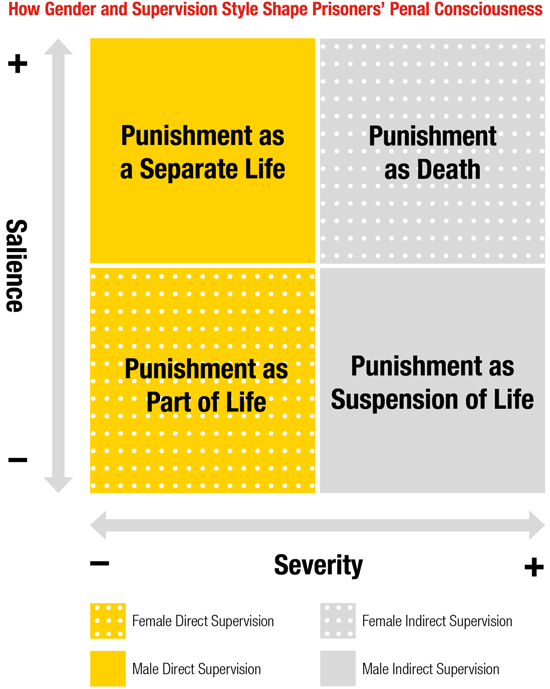A new theoretical framework looks at punishment from the prisoner's perspective and reveals how the lived experience of punishment differs from the punishment conceived by lawmakers "on the books."
While conducting dissertation research partially funded by NIJ at the University of California, Irvine, researcher Lori Sexton examined the experiences of 80 male and female persons under direct and indirect supervision in three Ohio state prisons.[1] How do they understand and orient to being in prison? Do they interpret punishment in different ways? She used qualitative interview data to develop the "penal consciousness" framework. This new theoretical framework moves beyond the objective aspects of incarceration to help us understand the subjective experience of punishment, specifically how do people who are incarcerated make sense of their time in prison.[2]
What Is Punishment?
Sexton first organized the punishments described by prisoners into two conceptual categories: concrete and symbolic. Concrete punishments — the presence or absence of concrete, material things — described by them included the breakdown of amenities (for example, microwaves, televisions and recreation equipment); the denial of appropriate hygiene and personal grooming products; the removal of privileges; and the imposition of administrative sanctions, such as disciplinary tickets, "early bed" and "cell isolation."
Symbolic punishments are losses and deprivations representative of something larger. Nearly all who were interviewed agreed that simply being in prison was a big part of their punishment. In addition, four symbolic punishments loomed largest for them: the related losses of autonomy, self and humanity — all connected to this loss of freedom — and the loss of family.
The Salience and Severity of Punishment
Sexton went beyond simply cataloging the array of punishments described by the 80 prisoners. She also looked at how the experience of punishment varies using two dimensions that arose inductively from the data: severity (the punishment's intensity as experienced by incarcerated persons) and salience (the importance of punishment in their minds and lives).
Sexton found that the severity of punishment exists on a continuum, ranging from extremely low to almost unbearably high. Notably, concrete punishment (for example, a high-sodium diet or overpriced toiletries) tends to be relatively low in severity, whereas symbolic punishment (for example, loss of freedom or severed ties with loved ones) tends to be far more severe.
While severity of punishment reveals intensity, salience reflects how prominent punishment is in the daily lives and minds of the incarcerated population. Like severity, salience exists on a spectrum from imperceptibly low to strikingly high. It depends not only on individuals' experiences of punishment but also on their expectations of punishment. The distance between what a prisoner expects and what he or she experiences — what Sexton calls the "punishment gap" — largely determines the salience of the punishment. Expectations vary widely and are influenced by first-hand experience or vicarious accounts of what prison is like, as well as prisoners' knowledge of appropriate punishments for certain crimes and their sense of fairness or justice.
Narratives of Penal Consciousness
As Sexton examined the interplay between severity and salience, four unique narratives of penal consciousness — or stories that they tell about the meaning and place of punishment in their lives — began to emerge from the data. These narratives do not describe types of prisoners; instead, they portray the different ways that they situate punishment in the larger landscape of what they consider to be their "real" lives. Because punishment is constantly in flux and prisoners continually reconfigure their experiences and expectations, these narratives can shift over time. And because punishment is multifaceted and complex, they may experience more than one narrative at the same time.
- Punishment as part of life: For those experiencing this as part of their narrative, punishment fits seamlessly into the course of their real lives. They see punishment as one of many unique experiences that make up a complete life history. This narrative is associated with them experiencing punishment low in both salience and severity.
- Punishment as a separate life: In this narrative, some individuals erect a boundary between their lives inside prison and the lives they lived on the outside. Life outside prison walls is rendered far less real as a result of their distance from it, while life inside prison becomes the only reality they know. Rather than being one chapter in the story of their lives, punishment forms a new story altogether.
This narrative resembles the first narrative (punishment as a part of life) in many ways. For instance, in both, they experience punishment low in severity. In punishment as a separate life, however, they experience punishment high in salience and thus consider the punishment more real than the lives they left behind outside prison walls. - Punishment as suspension of life: The study found that punishment that is low in salience and high in severity induces a feeling of stagnation and a sense of unreality in people who are incarcerated. For individuals experiencing this narrative, life outside prison continues under the auspices of "reality," while inside prison, reality and life are suspended. Punishment carries with it a skewed sense of temporality and a sensation of being stuck at a standstill while "real" life passes by in a blur outside prison walls.
- Punishment as death: Similar to those experiencing punishment as suspension of life, individuals who express this narrative see punishment as incompatible with life. But unlike those for whom punishment is simply a physical distancing or removal from a life that continues without them outside prison walls, individuals who experience punishment as death report an extinguishing of life altogether. These individuals describe punishment as a physical, psychological or spiritual death, ending their lives as they knew them. In this narrative, which is associated with punishment high in both salience and severity, a life of punishment is no life at all.
The Role of Supervision Style and Gender
Sexton next examined how gender and prisons' supervision styles shape prisoners' penal consciousness.
She found that the style of supervision used in a prison impacts penal consciousness in various ways. Direct supervision — designed to be a humane and humanizing form of incarceration — includes housing units with cells arranged around a common dayroom; commercial-grade fixtures inside cells and common areas; and amenities such as televisions, games, kitchen appliances and do-it-yourself laundry. These direct supervision housing units helped temper the symbolic punishments experienced as part of incarceration (such as the loss of freedom and family) and eliminated many of the concrete punishments entirely. The data showed that those under direct supervision tend to experience punishment as part of life and punishment as a separate life — both associated with low-severity punishment. In contrast, individuals in indirect supervision settings, which use traditional, linear-style cellblocks to house prisoners, tend to experience punishment as suspension of life and punishment as death, two narratives that portray incarceration as essentially incompatible with life.
As for gender, Sexton found that females often lamented the lack of consistency and routine in prison, and they most often expressed narratives of punishment that were either low in both salience and severity (punishment as part of life) or high in both salience and severity (punishment as death). Males, on the other hand, said that prison staff and procedures often lacked respect and fairness. They most often recounted punishment that was a combination of high salience and low severity (punishment as a separate life) or low salience and high severity (punishment as suspension of life).
When looking at gender and supervision style in concert, Sexton discovered that each group — women under direct supervision, women under indirect supervision, men under direct supervision and men under indirect supervision — was most likely to express a particular narrative of penal consciousness. Women under direct supervision were more likely to experience punishment as part of life, whereas women under indirect supervision were more likely to experience punishment as death. Men under direct supervision were more likely to experience punishment as a separate life, whereas men under indirect supervision were more likely to experience punishment as suspension of life. See figure below.
Potential Policy Implications
By studying the subjective experiences of incarcerated people, the penal consciousness framework allows us to understand variations in the lived experience of punishment and how punishment "on the ground" differs from the punishment conceived by lawmakers "on the books."
The gap between punishment on the books and punishment in action has potential policy implications. The criminal justice system is predicated on knowable, measureable penalties. But the subjective nature of punishment means that no single individual's punishment can possibly be known before it is experienced. As such, correctional officials may be able to develop management strategies that are attentive to differences in penal consciousness.
Reducing both the severity and salience of punishment as experienced by those who are incarcerated may be a viable way to achieve the rehabilitative goals of our correctional system. Sexton's findings suggest that direct supervision — which produces a low severity of punishment and is associated with the experience of punishment as compatible with life — has a normalizing, humanizing effect. Whether this effect has lasting, positive outcomes for their re-entry remains to be seen, but given our knowledge of the challenges of community re-entry, it offers a promising strategy to explore and research further.
For More Information
- Read an abstract and access the full report, Under the Penal Gaze: An Empirical Examination of Penal Consciousness Among Prison Inmates.
About This Article
This artice appeared in NIJ Journal Issue 273, March 2014.




